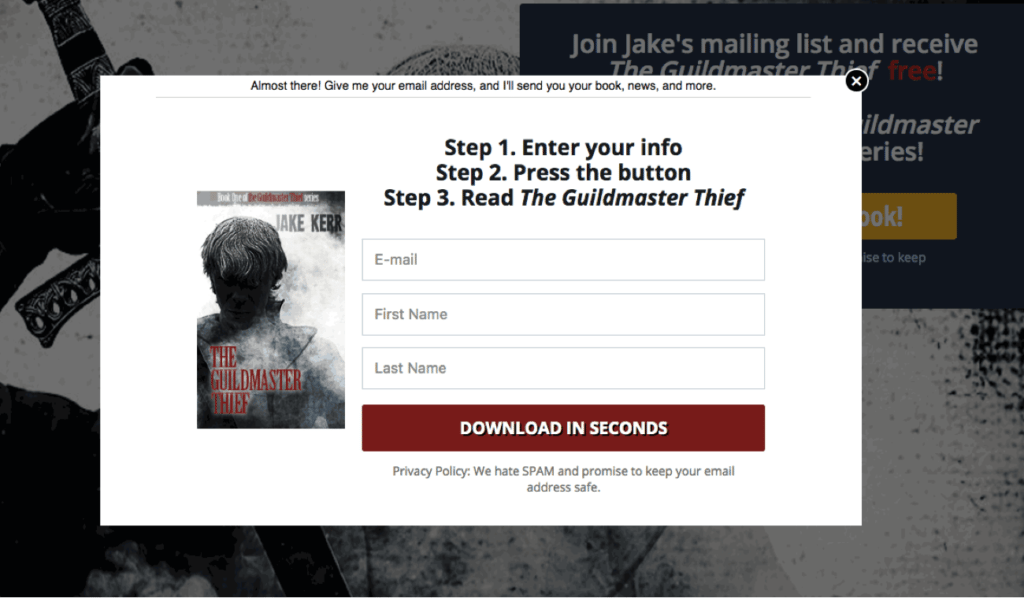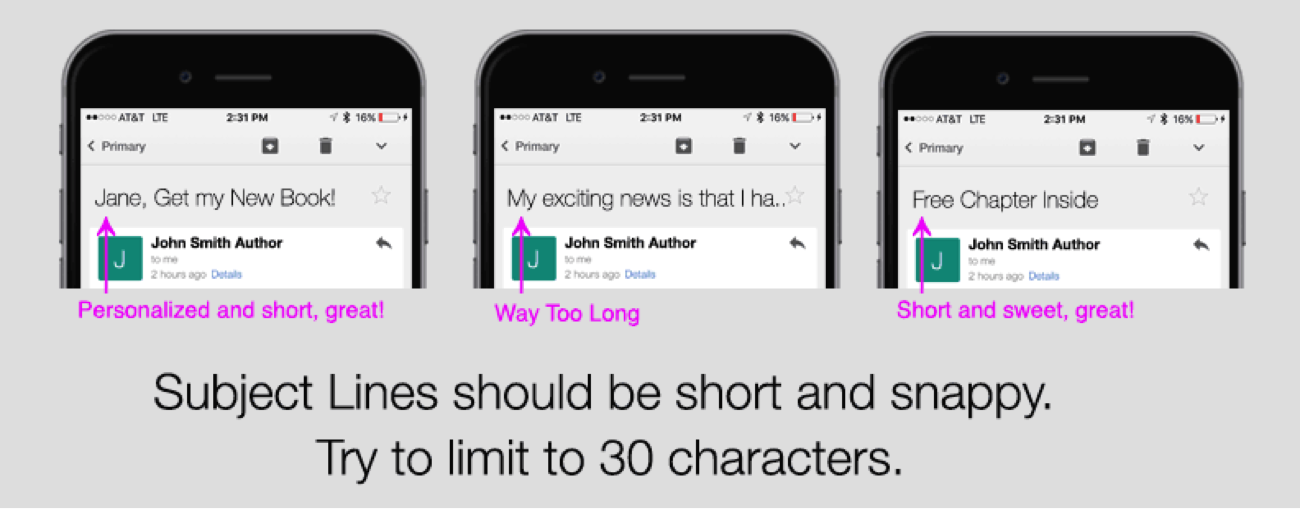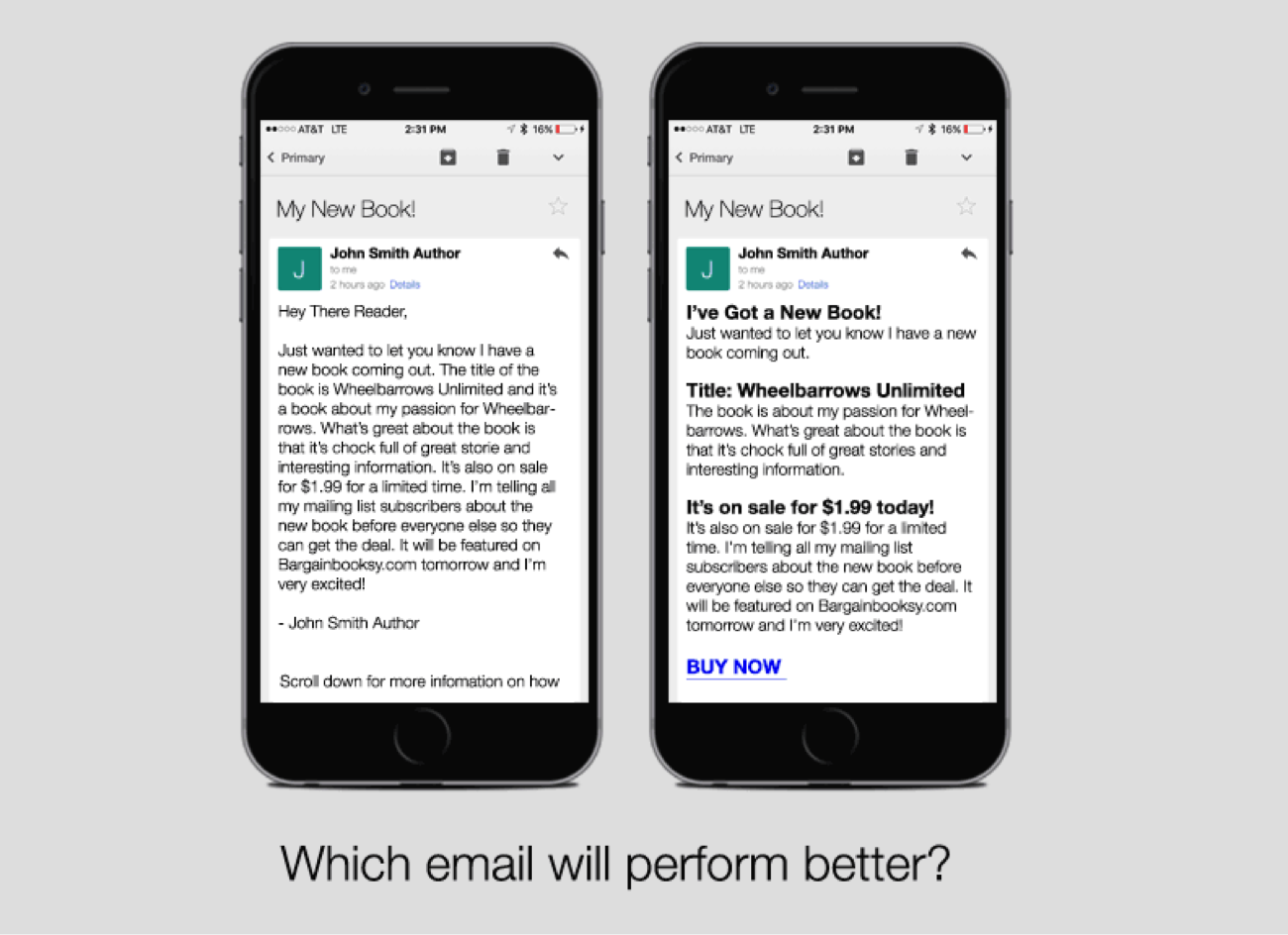Back in our 10 Trends in Publishing Every Indie Author Needs to Know post in 2016, we talked about the importance of email marketing for authors. That trend has stayed true, and email marketing remains one of the most effective tactics for driving book sales. Are you ready to join in on the trend? Keep reading for a primer on email marketing for authors, and learn how you can use it as an effective tool to sell more books.
What is Email Marketing?
Email marketing is exactly what it sounds like: marketing a product to a reader via email. As an author, there are two ways that you can utilize email marketing:
1. By creating your own subscriber list
2. By paying to access other people’s lists. This is what you are doing when you run a promotion with services like ours (Freebooksy, Bargain Booksy, Red Feather Romance, New in Books, and Audio Thicket).
In both situations you are getting your books directly into readers’ inboxes. Email marketing has always been a highly effective way to access readers, and with social media reach declining across most platforms, email marketing is even more important than ever.
A Common Misconception
Email sometimes gets a bad reputation for being spammy. The term ‘spam’ originated based on the overuse and unlawful use of email marketing. Email marketing is not spammy if you are a responsible email sender and provide your readers with valuable information. If your favorite author published a new book, you’d want to know about it, right? In fact, it might be annoying to not get an email about anticipated new releases. Email Marketing done right leads to readers wanting to get your emails. On this article we’ll highlight the best practices to making email a valid, effective, way to reach readers.
Vocabulary
Before we dive in, let’s define some terms that we use in email marketing to describe our efforts:
Subscriber: For you as an author, a subscriber is a reader who has opted into your mailing list.
Campaign: A “campaign” is what we call an email that is sent to a list of subscribers.
Subject Line: Your subject line is the first thing that a subscriber will see when your email hits their inbox.
Body: This is the content of your email. What subscribers see after they open it.
Open Rate: This is the percentage of subscribers who open your emails.
Click Rate: This is the percentage of subscribers who click on the links in your emails. Sometimes referred to as Click Through Rate or CTR.
If I’m building my own list, where do I start?
You will need two things in order to build an email list:
1. An email service provider (ESP)
2. A website
An email service provider (ESP) will help you gather and manage your subscribers, as well as allow you to craft, send, and report on your campaigns. Even if you don’t think that you need the reporting and design capabilities of an ESP (and trust us, you do), mass emails sent from a single email address are highly likely to get flagged as spam, so it isn’t recommended to gather email addresses, and simply add them to your gmail (or yahoo, or aol etc) address book.
We recommend starting with Mailchimp as an ESP. Their accounts are free for up to your first 2,000 list members, and their interface is really easy to use, both for campaign creation and reporting.
Pro Tip: When you login to your ESP, make sure the email address that you are sending from is an email address linked to your website domain, and not a free gmail or yahoo account. For example, make sure your email marketing comes from john@johnsmith.com not john.smith22@gmail.com. You need this to be compliant with DMARC, which is a complicated, but important rule. You don’t need to understand it, but you do need to comply.
Once you have an ESP, you need to start gathering email addresses. The easiest way to do this is to put a sign-up form on your website. Most authors use either WordPress or Squarespace. If are using Squarespace, MailChimp integration comes built-in, and we have a great video tutorial on how to setup a mailing list page. If you are using self hosted WordPress, we like the plugin MailChimp for WordPress, it’s not officially endorsed by MailChimp, but they do a great job and make it easy to add a mailing list form to your WordPress site.
You can read more about optimal author website design HERE (Pssst #5 will look familiar).
What information do I want from my subscribers?
ESP’s will allow you to embed signup forms either with a plugin or by adding the code directly to your website. Before you are ready to embed the form and start collecting emails, you need to decide what information you would like from your future subscribers. The more information that you gather from your subscribers at the beginning, the better you will be able to provide them with information that they find valuable once you start sending campaigns. We recommend collecting the following information from your readers:
1. Email address
2. First name (for personalization of email subject lines and bodies)
3. Zip code (if you are interested in doing local events, book tours, etc.)
You don’t want to ask for too much information, because it makes the sign-up forms long and a bit daunting for potential subscribers, but you do want to gather enough information that you can supply your subscribers with relevant information. Knowing a little bit more about your subscribers allows you to make your emails that much more personalized, which shows your readers that you care. Here’s a good example from author Jake Kerr.

How do I get subscribers?
Once you have your ESP selected and a live page with a sign-up form, there are a variety of tactics that you can use to prompt readers to join your list. Authors have an advantage over most other marketers as you already have content (your books) that you can leverage to build your email list.
- Offer a free story or free chapters in return for an email address
- To do this, add a link to a free download of one of your books in the welcome email that readers receive after subscribing to your list. This way, as soon as a subscriber confirms their email address, they will receive the link to the free content.
- Include a link in the back matter of your books
- At the end of your eBooks it is optimal to always include a link to your mailing list signup form.
- A great way to get started, or to grow existing lists, is to use services like ours to promote free and discounted eBooks, making sure to have an email signup link at the end of the story, so that all readers gained through promotions have the ability to become new subscribers.
- Sample text: Thank you for reading *Title*! If you enjoyed it, please subscribe to my mailing list to hear about future books!
- Run giveaways
- You can run giveaways for either eBooks or physical copies of your titles, with the primary entry option being submitting an email address. Rafflecopter has an integration with Mailchimp that makes this very easy by automatically adding giveaway entrants directly to your list.
- Tip: When running a giveaway, make sure your prize attracts the type of reader you want on your list. For example, giving away an ipad may get you many more entries, but the quality of those entries will be lower than the entries you get if you are giving away a Kindle. This is because almost everyone wants an ipad, but only readers want a Kindle. You want to choose a prize that attracts readers, ideally in the genre you write, which is why giving away a copy of one of your books will always result in the highest quality subscribers.
- Post a request to your social media followers
- Letting your social followers know that they can be even more “in the know” by signing up for your mailing list will always drive subscribes.
- You should do this immediately after setting up your ESP, but, as long as you’re gaining new fans, it makes sense to post email sign up links to your social followers every month or so. You can also pin an email signup link to the top of your Facebook and Twitter profiles to act as constant reminders for new fans.
- Implement a popup on your website
- You will want to have a page dedicated to your signup form, however, implementing a pop-up that prompts readers to sign up after they have been on your site for a given amount of time (recommended 10-15 seconds) will allow you to catch more readers. Popups, like email, sometimes get a bad rap for being ‘spammy’, but as long as you don’t use too many exclamation points, and are direct and honest in your popup, you will be fine.
- Dive into paid advertising
- You can use Facebook and Twitter ads to find new subscribers for your mailing list. We recommend budgeting for a cost of 50c – $3.00 per subscriber.
It is important to remember that this is all about marketing, which means that you are selling your books and your author brand. As you post to social media and create pop ups and sign up pages, do a little brainstorming about the kind of special content you want to share with your readers via email, and tell subscribers up front what the benefit of signing up will be. You have to have a hook. Will you offer sneak peeks, free books, prizes, exclusive sales? Think up your strategy and let them know!
There are some strategies that we absolutely do not recommend using to grow a list.
- Never Buy lists
- If a list is for sale, it is most certainly not going to be good quality. The most active and engaged subscribers will be the ones that personally opted in to your emails. Prioritize your time and money on acquiring readers who care.
- Never send to people who haven’t given you permission
- Sending emails to people who haven’t opted in to your list is a sure fire way to get flagged as spam, and generate complaints. Most ESPs have systems built in that record the number of complaints that your emails get, and if the percentage is too high, they will disable your account. It may be tempting to go through your rolodex (do people have those anymore?) or your address book and add everyone to your mailing list without their permission. Don’t do it.
I have subscribers… what next?
Now that you have subscribers, you need to communicate with them. We recommend setting a schedule for when your emails will go out and what you will include in each email. You don’t have to email your readers constantly to be effective. Start with monthly emails that highlight the following sorts of topics:
- New book releases
- Upcoming releases
- Tours
- Blog posts
- Share your writing journey, make it personal
- Special sales and promotions
- Instagram pics of things that are inspiring you as a writer
An email campaign has 2 main parts: Subject Line & Body. For both parts, it is good to remember that internet usage is primarily mobile, so it is paramount that your campaigns look good on mobile devices.
Subject line
In the same way that your cover is the first impression that readers will have of your book, the subject line is the first impression that people get of your marketing emails, so it’s important that your subject line is engaging. The first way to optimize your subject lines for opens is to keep them short and sweet, so they make sense when viewed through a mobile email client. The recommended length is under 30 characters.
Body
There are a few things that you can do to optimize for mobile performance in your email body:
- People don’t read, they scan
- Most people will scan an email quickly to decide if it’s worth reading, and only then will they actually read it. Use subheadings, bullets, and bolded text in your emails to make them more scan-able. Once you’ve completed the email, read only the headlines in succession and see if the reader can get the point of the email that way. If not, you need clearer subheadings. Don’t fool yourself by proofing your email on a desktop, MOST people will read your email on their phones so make it sure it looks good on a phone.
- Put buy links & important information at the top
- Make sure that all of the information you want your reader to see, and any buttons you want them to click, are no more than one scroll down in your email.
- Don’t overdo it with images
- We know that professionally designed graphics are pretty, but if the image files are too big they will take too long to load, and readers will give up before they even get to see them. You will need to include your book covers often, and that’s okay, just be sure to save them as a medium sized jpeg and you will be just fine.
How do I know if my emails are working?
The number of people on your email list is not an indication of the quality of your subscribers. So how do you know if you are building an email list with subscribers who are going to engage with you and buy your books?
There are three main metrics that we use to measure the quality of a list and the effectiveness of an email marketing campaign.
Open RateOpen Rate = Subscribers who open your email ÷ subscribers who receive your emailFor example: If you send your email to 100 subscribers and 35 subscribers open your email, your open rate = 35 ÷ 100 = 35% open rate
Your open rate is an indication of how good your subject line is. Was your subject line interesting and informative enough to get your subscribers to open the email?
These are some benchmark open rates by industry according to MailChimp:
Media and Publishing:22%
Marketing: 18%
eCommerce: 16%When considering the effectiveness of your list, it is also important to remember that the open rate for email campaigns often goes down as the list size increases. It is not unusual to see open rates above 60% when you have lists of only a few hundred people. As your list grows in the thousands your open rates will drop, bringing you closer to the benchmarks listed above. This is because the larger the group of subscribers that you’re sending to, the less targeted the email is going to be for each individual subscriber. This is why, when setting up your sign up forms, it is good to ask for just a few extra pieces of personal information, so you can target more specific groups of readers as your list grows.
Click RateClick Rate = subscribers who click a link in your email ÷ subscribers who receive your emailFor example: You send your email to 100 subscribers, 45 subscribers open your email and 5 subscribers click a link in your email, your click rate = 5 ÷ 100 = 5% click rate
Your click rate is an indication of how engaging your content is to your readers. Generally you will be asking readers to click on buy links, or links to your social media pages.
These are some benchmark click rates by industry according to Mailchimp:
Media and Publishing: 4.66%
Marketing: 1.99%
eCommerce: 2.45%Conversion RateConversion Rate = subscribers who take an action (purchase, download, complete form etc) ÷ subscribers who click the action-oriented link.For example, 5 subscribers click an Amazon buy link in your email. That day you sell 1 book on Amazon. Your conversion rate = 1 purchase ÷ 5 subscribers that clicked the buy link = 20%
Another example, 5 subscribers click a “Review my book” link. Within 48 hours you get 2 new reviews on Amazon. Your conversion rate = 2 reviews ÷ 5 subscribers that clicked the review link
When you do not have access to customer data at the store in which you are selling your books, it is difficult to calculate a perfect conversion rate as you cannot measure the action directly from email to purchase. The best you can do is extrapolate the activity based on the time frame of sending an email and the activity you see at the retailer.
A typical retail conversion rate is 3%. So for every 100 people who click a Purchase link on a site or in an email, only 3 people will actually purchase that item.
The key takeaway from the metrics above is that marketing works like a funnel, with only a small percentage of the people who make it in at the top, finding their way to the bottom of the funnel. So the key to building an email list that is effective in large numbers is to continually invest in growing the number of people on your email list. As you fill the top of the funnel, you will see more actions being taken at the bottom of the funnel.
This sounds like a lot of work. How much time should I spend on this?
Growing a mailing list does take time and some tinkering, but it is always an investment worth making. Remember that your subscribers are uniquely yours, and once you have acquired them, you will not have to pay to reach them again.
You should budget 4 – 6 hours to set up your email service provider account (ESP) and create your sign-up form. Once that is complete we recommend that you budget at least 2-3 hours per week to grow your subscriber list and engage with your subscribers. You will also want to look at the reports that your ESP provides to learn what is working and what is not.
Conclusion
If there’s one thing to takeaway from this article, it’s that email marketing for authors is a valuable tool in any author’s marketing toolkit. It does not replace any of your other marketing activities, like running price promotions, or managing social media, but it is a another effective tool available to you to promote your work. To recap:
- Email Marketing is the best way to reach your readers, because you own your email list.
- Setting up an email list is hard work, and has a learning curve, but if you can stick to it, you will be rewarded.
- Acquiring new subscribers requires a variety of techniques such as social media marketing, paid marketing, effective use of eBook backmatter, and giveaways.
- Your emails should have short subject lines, clear subheadings and only a few images.
- Your emails must be mobile-friendly .
- Measure success by the quality of your list, not the quantity of subscribers. You measure quality by assessing the open rates, click rates and conversion rates of your subscribers.
- Email marketing is a marathon, not a sprint. Plan to invest time, money and resources into building and engaging your list.



Thanks for this. Great info for authors (a.k.a. marketers).
Just want to say thank you for all of the information… It is nice to get advice from those who have been in the same boat as yourself, and with the ever growing popularity of self publishing it is a must. The fact you hand over this info for free is specially wonderful, because it seems everyone has some advice as long as you pay for it. I personally write because I love telling tales. I never gave thought my writing would bring me wealth. I simply love storytelling. I have never thought of myself as a writer, but I have always thought of myself as one heck of a storyteller, and so I decided to place my work out there for readers interested in my style. Thank you and happy trails until we meet again.
Hi, after reading this remarkable post i am also glad to share my knowledge here with friends.
It’s actually a cool and useful piece of
information. I am happy that you just shared this helpful info with
us. Please keep us up to date like this. Thank you
for sharing.
Great info. Lucky me I found your blog by accident (stumbleupon).
I’ve book-marked it for later!
This blog is really helpful regarding all educational knowledge I earned. It covered a great area of subject which can assist a lot of needy people. Everything mentioned here is clear and very useful.
THANKS, CHLOE,
This is very helpful. I’m just finding it difficult to understand the concepts and getting going with it. It’s like I need a step by step guide. But I suppose it takes time and as you say it’s a learning curve. Who’d have thought that writing children’s stories has to be so involved in order to reach potential buyers? Thank you so much for this useful and informative post.
Extremely helpful and informative, particularly as I’m half way through my second book in a series of seven (not yet published).
I don’t have a website and I thought email marketing was for marketing companies alone. Well, that’s given me the kick up the backside I need. I’ll get on with setting up my website and then sort out the email marketing.
Thank you so much,
Karen